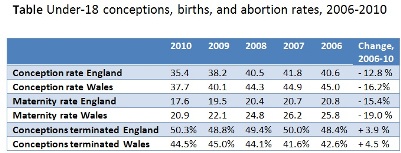Teenage pregnancies: looking on the dark side
Good news about declining teenage conception rates was reported negatively today in Wales, the headline in the Western Mail reading: “Midwives’ note of caution as teenage pregnancies plunge”. It added as a sub-heading: “Concern as the abortion rate is double average.”
There’s always a dark side, if you look hard enough. But in this instance I think the Celtic gloom is overdone. The paper quoted Helen Rogers, director of the Royal College of Midwives in Wales, as saying: “I would be concerned at the lowering of the pregnancy rate if the abortion rate remained high. If it is being used as a form of contraception, then that is a worry.”
Of course abortion is being used as a form of contraception. It always has been. It may not be ideal, but however much effort is put into safe-sex education it’s hard to envisage the day when every fumbling teenage embrace is interrupted by a search for condoms. That’s not the way teenagers behave.
Besides, a look at the full figures (Table) which were published last month shows that while the proportion of under-18 conceptions ended by termination has increased modestly in Wales over the past five years, the same is true in England. And in both cases the percentage increases are far lower than the falls in conception rates.

The reduction in completed pregnancies – greater in Wales than in England – has in both countries been driven more by declining conception rates than by rising abortion rates, though both have contributed.
The abortion rate in under-18s is double that of women as a whole, the report says, which is true. Actually it’s more than double, but that’s a false comparison, since under-18 pregnancies are almost all out of wedlock. If we compare the abortion rate in under-18s with that of all conceptions outside marriage, the difference is less marked. While 44.5 per cent of under-18 conceptions were terminated in Wales in 2010, the figure for all conceptions outside marriage for England and Wales was 30.1 per cent. (This statistic is not broken down by region.)



